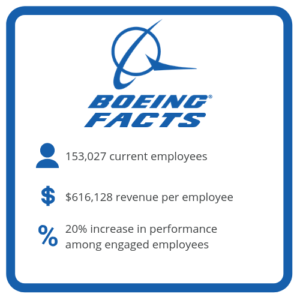In this article I’ll walk you through each step in a straightforward Voice of Employee analytics program. I’ll demonstrate how data scientists, workforce analysts and other HR professionals can gather, prepare, analyze and interpret employee reviews and other employee feedback data to increase employee retention, reduce hiring costs and improve workforce productivity. And best of all, I’ll demonstrate how you can do this without any coding or data science experience!
First I start at the macro-level by investigating the discussion topics, themes and sentiment in a set of Glassdoor reviews written by Boeing employees. Next, I dig into the details. I identify areas for organizational improvement, discover their root causes, and then we make actionable recommendations that further organizational goals.
Contents
Finding and Sourcing Employee Experience Feedback
Preparing Employee Feedback Data For Analysis
Creating a Configuration and Running an Analysis
Visualizing High-Level Discussion Topics and Themes
Identifying Areas for Organizational Improvement
Tracing Problems Back to Their Root Causes
Examining Individual Reviews to Gain Context and Humanize the Data
Proving the Value of Human Resources
Quick note: I used the Lexalytics, an InMoment company, Spotlight application to create analytics dashboards for this article. But you can apply the general processes outlined here to any employee feedback analytics tool.
Introduction: The Value of People Analytics & Voice of Employee
Retaining an employee is 21% cheaper than replacing one. But employee turnover is at a record-high. Human Resources departments are the frontline for this battle, and a British not-for-profit consultancy says that real business value is realized when Human Resources is deployed effectively:
“If employees are able to speak up about what’s important to them and what’s achievable, HR can design incentive schemes that better orient employees towards meeting organizational goals.”
Yet many HR teams lack the resources or data-driven approach they need to make a real impact. According to Mike West, author of People Analytics for Dummies and father of the “People Analytics” movement in HR, this is because “it is not clear how to relate HR actions to business impact.”
But there’s hope. As I demonstrate below, HR teams can use Voice of Employee (VoE) analytics to prove the bottom-line impact of their work by reducing employee churn, improving productivity and increasing engagement.
Finding and Sourcing Employee Experience Feedback
As with any data analytics program, Voice of Employee should start with a question. For this article, we’ll pretend that I’m a workforce analyst at Boeing, the aerospace/defense giant. My question is:
How can we reduce people-related constraints and achieve larger business goals?
To answer this question, I need data. And the best data for VoE comes from employees themselves. (Natural-language feedback is known as “the voice of employee”.) So, I gathered 6,000 Boeing employee reviews from Glassdoor.
To gather this data, I used the web-scraping program WebHarvy. You can find an easy tutorial on how use WebHarvy to scrape Glassdoor reviews here. At $11 a month, WebHarvy is a fast, affordable tool for gathering text data.
Preparing Employee Feedback Data For Analysis
Great! Now I’ve gathered my employee feedback data (Glassdoor reviews) and exported it into Microsoft Excel. But before I can analyze anything, I need to clean and prepare it.
Voice of Employee data sets usually contain at least three columns: ID, text, and date. An ID is just an arbitrary number representing a row in the data set. The machine uses the ID to index each row of data. Text is the natural language document (like a Glassdoor review, survey response, or Slack message) that you want to analyze. The date indicates when the employee created the document.
Of course, your data may include many more columns beyond these items. These additional columns are called metadata: data about data. For voice of employee, metadata may consist of the manager on duty, the office location, the department or team an employee belongs to, or anything else you can think of that’s relevant.
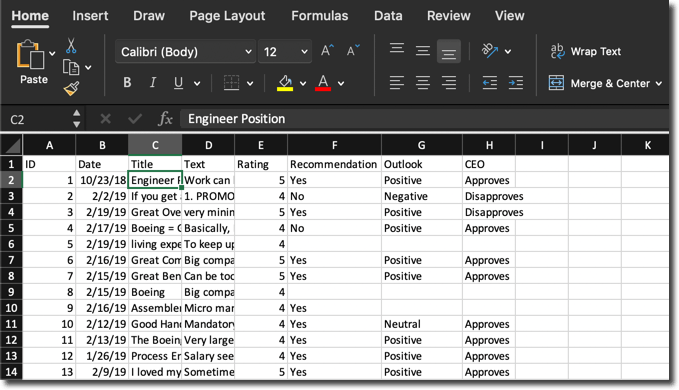
For my analysis, I’ve opted to use eight columns: ID, date, title, text, rating, recommendation, outlook, and CEO. Title is the title of the review; rating equates to the number of stars the employee used to rank their employment at Boeing; recommendation is whether or not the employee recommends working at Boeing; outlook is their overall outlook for the company; and CEO is the employee’s opinion of the CEO of Boeing.
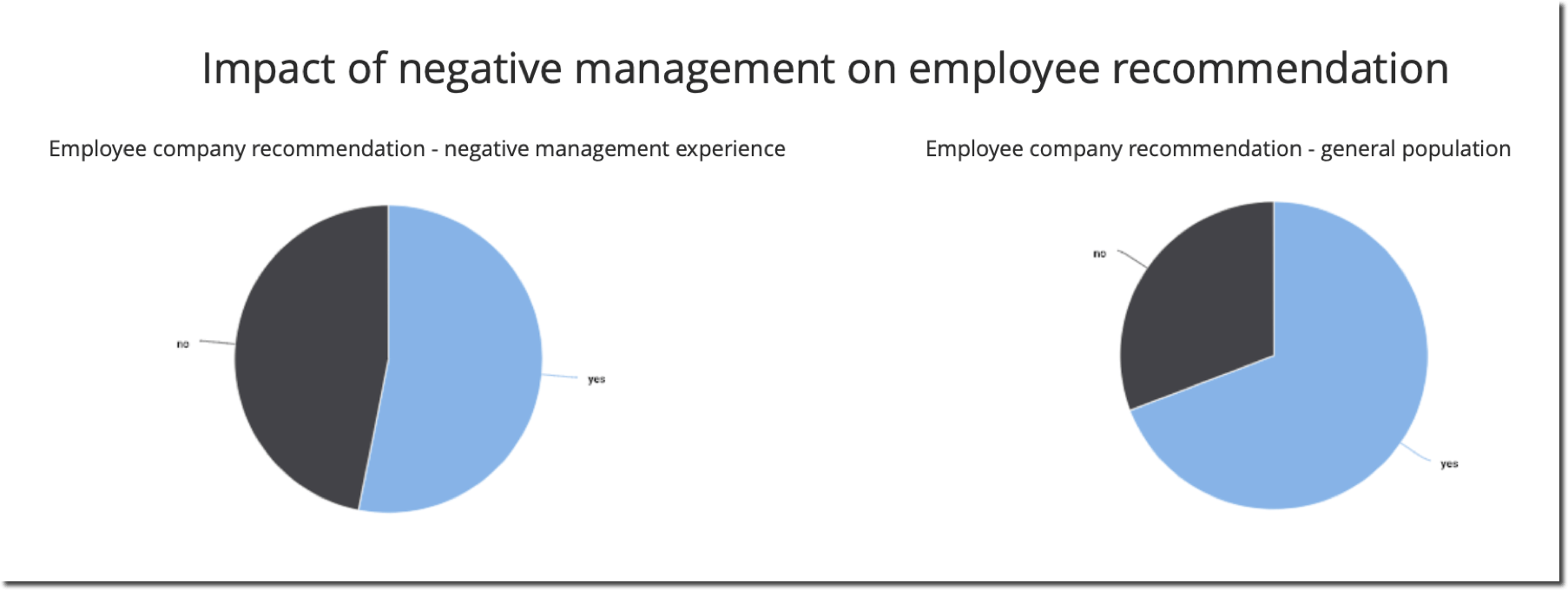
Next up is data preparation. Preparing a data set for analysis involves purging irregularities that might cause errors with your analytics tool. For example, you can check random data samples for misspellings or erroneous characters. In this case, I prepared my data by simply scrolling through the data set and looking for irregularities. Then I fixed or deleted irregular data using the Microsoft Excel replace feature.
Now I’m ready to configure and run an analysis.
Creating a Configuration and Running an Analysis
When you (a human) talk with your friend (another human), you use context to gain deeper understanding. For example, you interpret their facial expressions and tone of voice, as well as your history with them. These elements help you understand deeper meaning behind the words they use.
When you talk to a machine (such as writing a review or posting a social comment), however, that machine doesn’t have that learned context (because it’s a machine). In order to account for this, data analysts tell the machine how to interpret specific words and phrases in a larger context. This process of adjusting for context is called tuning – and you create a configuration to “remember” your adjustments.
Remember: my goal with this VoE analytics project is to understand what Boeing employees are talking about, how they feel and why they feel that way. But without a proper configuration, the insights I generate will be questionable at best, and downright misleading at worst.
Tuning is a critical step in any analytics project that involves natural language data. But it can be hard work to build a configuration from scratch. That’s why some Voice of Employee vendors provide pre-built configurations, like the Human Resources Industry Pack from Lexalytics.
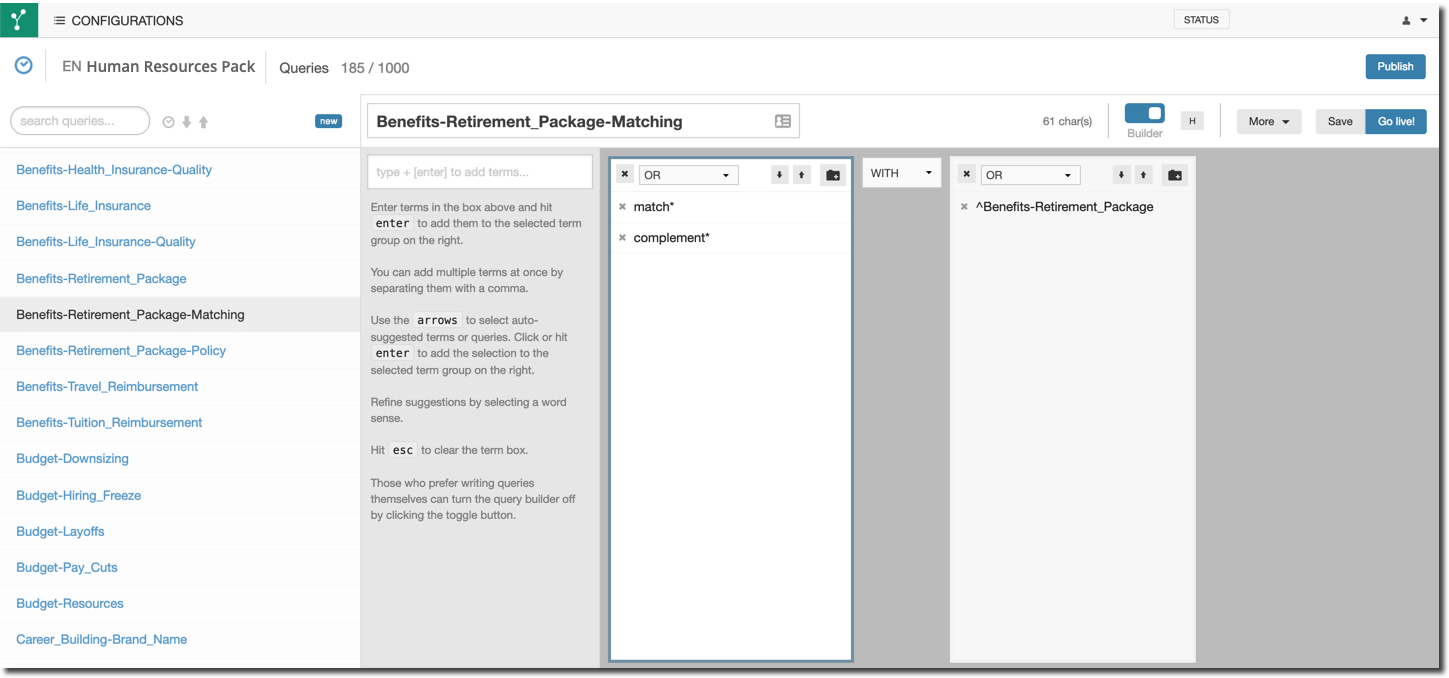
Pre-built configs let you focus on running analyses, instead of building configurations.Nonetheless, it’s important to understand that a pre-built configuration is a foundation for you to build on. Depending on my data, I may also want to tune the configuration for Boeing specific entities, products, or programs.
Different vendors handle tuning in their own way. Lexalytics uses a point-and-click graphical dashboard that lets you take a pre-built industry pack and then further tune it to improve accuracy. The process is quick, intuitive, and code-free.

Visualizing High-Level Discussion Topics and Themes in Employee Reviews
So far, I’ve gathered, cleaned, configured and analyzed employee reviews. Now I’m ready to create visual analytics dashboards that will help me understand what’s in the data. To do this, I’ll use Lexalytics’ Spotlight, a BI platform for text data.
Large data sets can be overwhelming, especially when they’re full of messy natural language. So, I start high-level. Instead of diving into the weeds, I “zoom out” to observe relationships between entities and themes.
Collocation is a term for visualizations that help analysts zoom out on a data set. In text analytics, collocation shows how frequently two concepts appear next to each other in a set.
In Voice of Employee, this macro approach helps us tell powerful stories about an employer’s brand health, and then identify the root causes of organizational issues. HR professionals may want to begin visualizing their data through a widget like Spotlight’s sunburst chart.
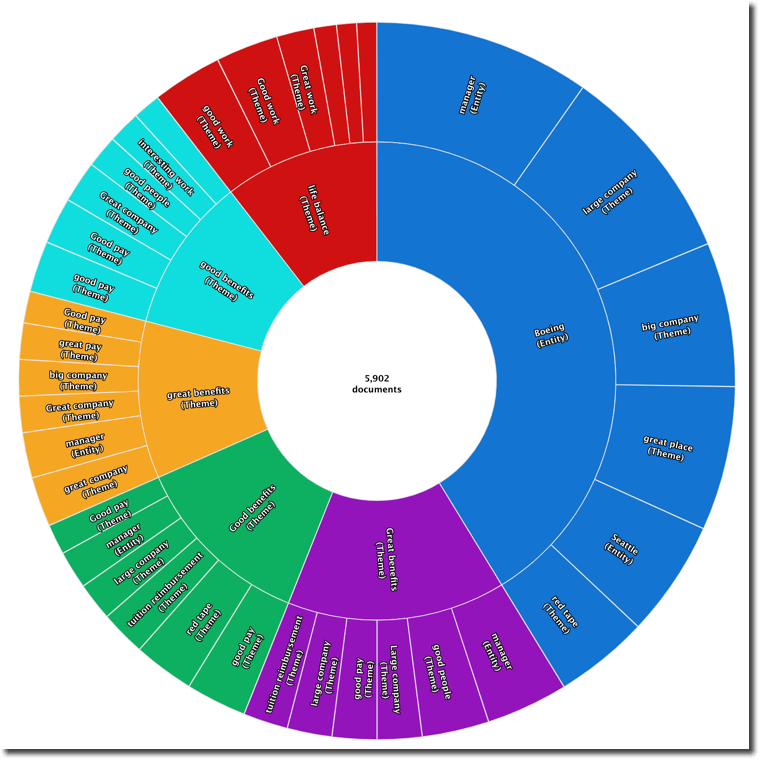
In this case, I can immediately see that some Boeing employees express concern that ageism plays a role in corporate pay structure. For a workforce analyst tasked with improving employee retention, an insight like this can make the difference between success and failure. More on that later.
In the meantime, with just one click I can see what else is being discussed in relationship to “ageism.” Or, I can drill into the underlying documents and hear the voices that support this claim.

Here, I use the sentiment polarity visualization to illustrate Boeing as an employer. I can see that most of my documents (read: Glassdoor reviews) are weighted as “very positive.” This means that employees mainly use positive language in their reviews.
But remember the goal of my project: to provide actionable insights drawn from employee feedback that can either improve retention or reinforce organizational cohesion. Or, in shorter words: to get some useful ideas out of this mass of data.
So, while it’s nice to know that employees are generally happy, I need to go deeper. To do that, I filter the visualization to show only reviews that express somewhat negative or very negative sentiment (representing upset or dissatisfied employees).
Identifying Areas for Organizational Improvement
Now I’ll focus on areas with a high volume of negative sentiment. These documents demand my attention because they represent a threat to employee retention. But the same reviews can also tell me how to reduce employee turnover.
My analysis of Boeing’s Glassdoor reviews indicates that the main areas negatively affecting employee engagement and productivity are layoffs, technology, and pay structure.

Tracing Problems Back to Their Root Causes
Now that I’ve identified areas of employee dissatisfaction, I need to trace their root causes and provide my management team with specific actions they can take to address those issues.
Filtering on the topic of “Budget-Layoffs,” I see the sentiment of employees who are upset with layoffs within Boeing. This visualization reveals that the topic “Budget-Layoffs” ranks very poorly (-1.25) in reviews where employees complained about layoffs or budget issues.
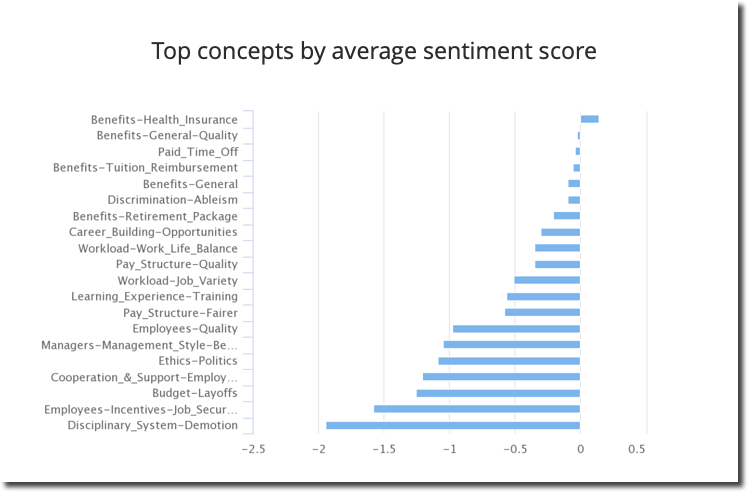
Of course, this insight isn’t exactly news-worthy. And sometimes a review site like Glassdoor serves as platform for ex-employees to vent their frustration. But an obvious trend can lead to valuable insights when you dig into the data. So, I’ll dig in.
Examining Individual Reviews to Gain Context and Humanize the Data
Next I examine individual documents (Glassdoor reviews) to gain context and identify how this data impacts the organization as a whole. To do this, I segment my analysis by the “Layoff-Budget” topic. My analysis reveals major, company-wide issues. For example:
“There is too much influx with employment. Employees live in fear of layoffs and too many politics with the company.”
A constantly-changing workforce means less productivity, and more errors by the stressed-out, distracted workers who remain. At an aerospace and defense company like Boeing, this can be disastrous.
can be disastrous.
Indeed, as I examine more reviews, I continue to see a trend of fear and confusion amongst Boeing employees:
“Lack of team-working due to continual competitive environment and fears of layoff.”
One employee points to an organizational flaw that may be responsible for the trend in the first place:
“They ramp up hiring WAY more than they should, only to end up going through layoffs down the road.”
To recap, first I found that the topic “Budget-Layoffs” had a very negative sentiment score. Then, rather than accepting this as obvious and moving on, I asked myself, Why? By digging into individual reviews, I revealed major issues with the way Boeing manages its workforce.
What can I recommend based on this analysis? In sum: Boeing should re-evaluate their hiring needs, stabilize their workforce, and communicate more effectively. This will improve their profitability through better employee retention, lower hiring costs, and higher productivity. Not heeding this advice will likely hurt Boeing. Indeed, they already face $1.6 billion in pretax accounting losses due to retiring baby boomers.
This is a great example of how an HR analyst can use Voice of Employee to uncover big organizational issues and then trace the root causes into individual comments that provide vital supporting evidence.
Finding Another Issue and Tracing its Root Cause: Boeing Employees Want Better Technology
With my VoE analytics process in place and already delivering useful data, it’s time to examine other causes of negative employee sentiment. Next, I’ll look at the topic “Employees-Quality,” which has a strongly negative sentiment score of -1.23.
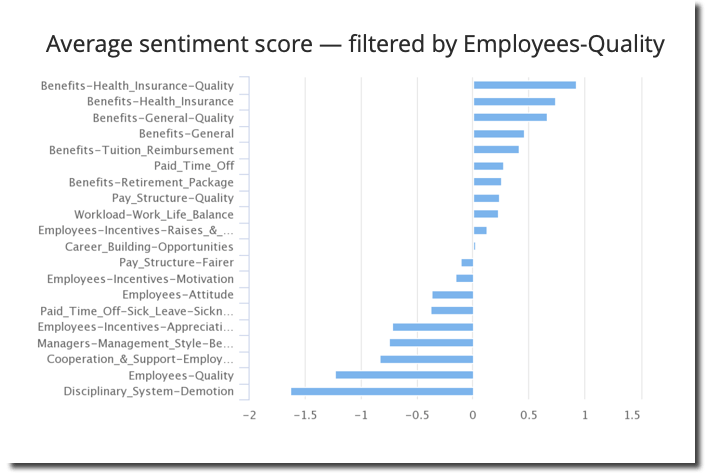
This time, when I examine individual reviews, I find an unexpected cause:
“100 year old company and feels like it.”
In fact, I find this sentiment throughout many Boeing employee reviews. Looking deeper, I find that a major cause of these complaints is their facility technology.
“Technology is archaic.”
The trend in negative sentiment continues, even disparaging the “old” digital applications still being used 2019.
“Lots of old applications still in production and by old I mean OLD and ugly, ColdFusion, etc.”
How can I make use of this insight? I would bring a data-driven visual report on strategic capital expenditure to my management team, backed up with specific, explicit comments from these employee reviews.
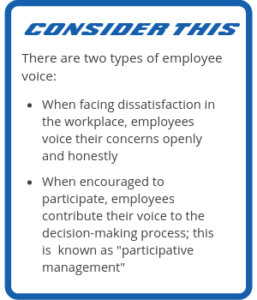
In this case, my report may compel Boeing’s IT leadership to improve or replace critically-outmoded software and technology. This would both increase employee productivity overall while reducing turnover.
And remember: In the age of People Analytics, Human Resources is no longer limited to hiring and firing. HR — once viewed as purely reactive — is using data science to take on proactive initiatives. By sharing the results of my People Analytics program with other teams, I can become a valued ally in the drive to improve profitability across the company.
Examining Pay Structure: How to Improve Retention
My final visualization reveals how employees feel about the topics of pay and incentives. Below, I’ve filtered the data for the three wage-related topics: “Pay-Structure-Quality,” “Pay-Structure-Fairer,” and “Employees-Incentives-Morale.” These topics have average sentiment scores of –1.07, -0.96 and -1.89 respectively.
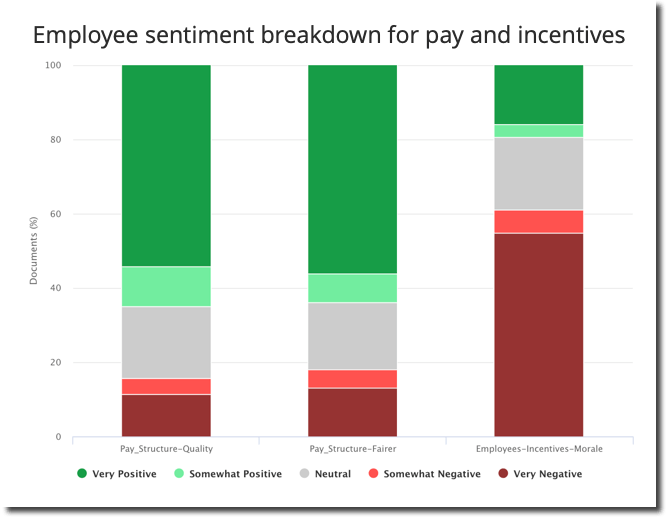
Money is always a touchy subject in the employee/employer relationship. But drilling down into individual reviews uncovers a troubling trend in Boeing’s compensation structure.
“They don’t promote or pay for performance but for time served”
Indeed, many negative reviews point to Boeing’s pay structure as a cause for anger, especially among young or newer employees.
“Poor starting pay. I would not recommend it to those just starting their careers”
“Big age gap between workers. Difficult to change anything.”
“Not a good place for young people to grow.”
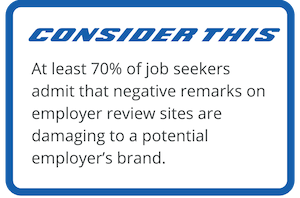
This crisis among younger employees and applicants poses a real challenge for a company like Boeing. Aviation consultancy Leeham Co warns that Boeing risks losing thousands of engineering, technician, and touch-labor personnel to retirement over the next five to 10 years, with a limited talent pool for replacements. In fact SPEEA, the engineers’ union, reports that 29% of Boeing’s engineering workforce is over 55.
Without a proper VoE analytics program to uncover insights like this, Boeing could face a major talent crisis. But, if their HR team is actively listening through analyses like those I’ve done above, they can spot this trend before it hits the tipping point and help the company’s management team avert a catastrophe. For example, they could recommend that Boeing’s payroll executives make reasonable changes to compensation and incentive programs for younger and newer employees.
Summary: Proving the Value of Human Resources Departments Through VoE Analytics
By beginning with a high-level view of topics and themes and then digging down into individual reviews, my analysis of Boeing employee reviews brought me:
- Clear areas of organizational improvement
- Detailed context, root causes, and supporting evidence
- Specific recommendations that their HR team can act on to increase employee retention and improve workforce productivity
This analysis serves as a roadmap for Human Resources departments everywhere. Currently, HR departments are frequently mischaracterized as not contributing to business revenue. This misconception will be broken when you deploy a data-driven VoE analytics program. Your team will operate as the nexus between employee relations, workforce optimization, and overall profitability.
Truth is, the abundance of data can be overwhelming unless it’s put to use in a clear, actionable analytics program. As an HR professional, you should build a structured People Analytics program to bridge the gap between employee data, your organization’s business objectives, and the goals of your employees themselves.
The insights generated by your People Analytics/VoE program will be multi-layered. They will be as high-level as a general overview of employee morale across the company, all the way down to a granular look at how tech-savvy your sales team is and if they need new laptops.
Next Steps: Reading and Resources
Want to learn more? Read our guide, People Analytics and Voice of Employee: What, Why and How to learn how People Analytics and VoE go hand-in-hand. From ComputerWeekly.com, learn how forward-thinking companies are listening to employees (using VoE analytics programs like I demonstrated above). And from TechTarget, read more about how employers are using sentiment analysis (What is sentiment analysis?) to discover what employees really think.

Want to explore Spotlight for yourself? Contact us to setup a demo or trial.
Want to get your hands on the data we used for this article? Contact us. We’ll send you fully-prepared data sets of Glassdoor reviews for the 5 largest insurance companies and the 5 largest aerospace/defense firms.
